| WAAFs at Driffield and Foulsham – 462 Squadron RAAF |
Some Members of the Women's Auxiliary Air Force who served at RAF Driffield (4 Group) or RAF Foulsham (100 Group), thereby assisting 462 Squadron's Operational Duties, when flying from those locations.
Names have been extracted from "Brave & True", (book details in Acknowledgements) and also from photos with identification recorded, as received from the 466/462 Squadrons' Association; or from the Aviation Heritage Museum of WA; or from the Australian War Memorial; or as contributed by former WAAFs or their families. More names may be added if, and when, other WAAFs are identified. However, it is not intended as a comprehensive list of all WAAFS at both RAF Stations, but mainly those who served alongside 462 Squadron.
Rank included, if known ........
ACW2 – Aircraftwoman 2, equivalent to AC2, Aircraftman 2 for RAF
LACW – Leading Aircraftwoman, equivalent to LAC, Leading Aircraftman for RAF
Cpl – Corporal, same as for RAF
Sgt – Sergeant, same as for RAF
F/Sgt – Flight Sergeant, same as for RAF
Sec/O or S/O – Section Officer, equivalent to rank of Flying Officer in RAF
wef –- with effect from
Links to .... Driffield WAAFs by name; Foulsham WAAFs by name;
Photos of Driffield WAAFs; some additional information for Driffield WAAFs;
large section for Catherine Josephine WOOD-BROWN of Met Office, Driffield (photos followed by information);
WAAF recruitment poster; photo of Foulsham WAAF;
large section for Winifred Joan HAWGOOD of Signals, Foulsham (photos, followed by information).
WAAFs at RAF Station Driffield, 4 Group – assisting 462 Squadron (August 1944 to December 1944) and 466 Squadron.
names in bold font have additional information in a later section.
Sec/O Officer M STEVENS – Intelligence Section
Cpl Dorothy ISHERWOOD – Intelligence Section
LACW Muriel SMITH – Intelligence Section
LACW Josie UNDERHILL – Intelligence Section
Sgt Catherine CAMERON ("Tommy")
Sgt Catherine CAMPBELL
Sgt Dorothy PETTMAN
Sgt Annette JAMES ("Jimmy")
Sgt Marjorie GILBERT
Sgt Nancy WILSON
Sgt Kay IRVINE
Sgt ........ (a cook)
F/Sgt ........ (admin staff)
Sgt ...... 2 un-named (in group photo)
Sgt Nancy GIBSON
Sgt Maureen K McMASTERS ("Mack")
Betty ....... – Transport Driver
Peggy MILLS – General Duties, batwoman at Officer's Mess
Ann PENNY
Margot ...... (married name DAVIS) – Wireless Operator, Signals (in photo with José WOOD-BROWN)
Cpl Catherine Josephine WOOD-BROWN (José) – Meteorological Section
LACW ...... DAVIES – Meteorological Section
LACW ...... HAWKINS – Meteorological Section
LACW ...... 2 un-named – Meteorological Section (in group photo)
Return to top
WAAFs at RAF Station Foulsham, 100 Group – assisting 462 Squadron (January 1945 to September 1945) and 192 Squadron RAF (and other Units).
In their book about 192 Squadron "Espionage in the Ether", William J Rees and John E Rees, advise that RAF Foulsham provided accommodation for 355 WAAFs, housed on their own site (book details in Acknowledgements).
Un-named – Waitress from the Squadron Mess
ACW2 Winifred Joan HAWGOOD – Signals, Control Tower, and Nissen Hut 2 on WAAF Site
Joan BAXTER – Signals, Control Tower, and Nissen Hut 2 on WAAF Site (in photo with W J HAWGOOD)
Sheila ...... – Signals, Control Tower, and Nissen Hut 2 on WAAF Site (in photo with W J HAWGOOD)
Return to top
|
WAAF personnel, DRIFFIELD
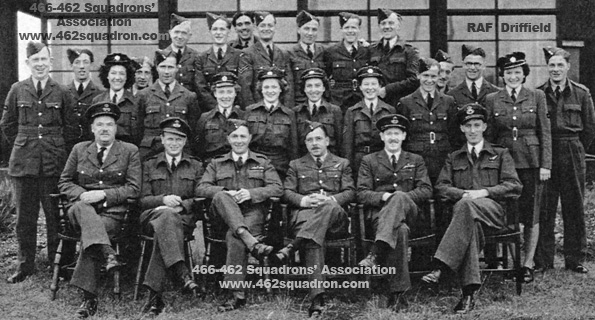
Driffield Control Tower personnel, assisting 462 Squadron and 466 Squadron.
Front: 3rd from left – Wing Commander MOORE, DFC, Officer in Charge (the only person identified in the original caption).
Middle row: Six WAAFs, numbers 3, 6 (Sgt), 7, 8, 9 (Sgt), and 13 (LACW), distinctive in their caps with WAAF badge.
8 may be Annette JAMES ("Jimmy")
9 may be Sgt Catherine CAMERON ("Tommy")
13 may be LACW HAWKINS of the Met Section
The other three WAAFs may also be in group photos of Sergeants or Met Office personnel, shown below.
Identification would be appreciated – please make contact if you can assist.
|
_(Admin)_Wilson_X_Irvine_web.jpg)
Driffield, 10 WAAF Sergeants, assisting 462 Squadron
Back, L to R: 1. Not named; 2. Catherine CAMPBELL;
3. Dorothy PETTMAN; 4. Annette JAMES ("Jimmy");
5. Marjorie GILBERT.
Front, L to R: 1. Not named (a cook); 2. F/Sgt not named (Admin);
3. Nancy WILSON; 4. not named; 5. Kay IRVINE.
|
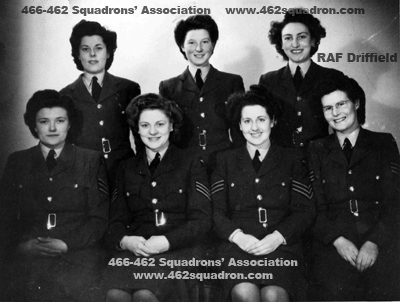
Driffield, 7 WAAF Sergeants, assisting 462 Squadron
Back, L to R: 1. Nancy GIBSON; 2. Catherine CAMERON ("Tommy");
3. Annette JAMES ("Jimmy");
Front, L to R: 1. Dorothy PETTMAN, 2. Catherine CAMPBELL;
3. Kay IRVINE: 4. Maureen K McMASTERS
Return to top
|
Additional information – WAAF personnel at DRIFFIELD
Sec/O M STEVENS – Intelligence Section
There are 3 WAAFs with the surname STEVENS, listed in the WAAF Administrative and Special Duties Branch, in the Air Force List of July 1945. It is probable that the Driffield STEVENS is one of these.
M K STEVENS to rank of A/S/O wef 07 Feb 1945
J M STEVENS to rank of S/O wef 02 Mar 1944
and A M STEVENS to rank of S/O wef 26 Jan 1945
LACW Muriel SMITH – Intelligence Section
Muriel later married Sgt Ernest BLOWMAN, who was also in Intelligence Section of RAF Driffield (ref: "Brave & True")
Sgt Catherine "Tommy" CAMERON
Sgt CAMERON was Scottish, and married S/Ldr Ted EAGLETON, a Pilot of 466 Squadron, Driffield, on 23 August 1945 (ref: "Brave & True").
She may also be seen in a photo on SHANNON Crew 01 page, in a group of 12, after a DFC Investiture at Buckingham Palace, March 1945 (AWM photo UK2638) – identified as ....
9. Sgt Cameron WAAF, Scotland; and 10. F/O W E Eagleton 403727 (William Edmund EAGLETON, DFC and bar, RAAF)
Peggy MILLS – General Duties, batwoman at Officer's Mess, Driffield, from May 1944 to September 1945, at age 18 years. Her initial training was at Wilmslow, near Manchester.
In a narrative in "Brave & True", Peggy told of early starts at 6am to prepare tea at the Mess, to waken the Officers at 7am. Some Officers lived in huts onsite but a distance from the Officers' Mess; others lived in detached houses, about eight to a house. Peggy looked after about 20 Officers in huts. Duties included the early morning wake-up tea, and later making their beds, cleaning their rooms, pressing uniforms, and taking laundry. She said .... (quote)...
"After a while you got used to seeing an empty bed – someone not returned from ops. My first service boyfriend was at Driffield and was an airgunner with 462. His birthday was the same as mine but he was one year older. He went out on a mission on the 9th October 1944 and didn't return at 19 years old. I wanted to die but you get over it".
This referred to Sgt Denis Roy MUXLOW, Rear Gunner for Pilot Coleman and Crew 29. All seven of the crew were killed on 09 October 1944, on a night Op to Bochum. Date of birth for Denis was 03 April 1925, so Peggy's birthday was 03 April 1926.
News from Peter MUXLOW in May 2023 was that Peggy had passed away (date not advised), aged 92.
Return to to
|
Cpl Catherine Josephine WOOD-BROWN (José) – Meteorological Section, Driffield, July 1943 to January 1946 |

Above: WAAF Catherine Josephine BURTON (later WOOD-BROWN),
later posted to Driffield, assisting 462 Squadron and 466 Squadron.
Photo at right: WAAF Catherine Josephine BURTON (later WOOD-BROWN), and fellow WAAF trainee at Morecambe, Lancashire, early 1942, where they did their "square-bashing". In a narrative in the book "Brave and True", José tells of when she was initially '"kitted out" at Gloucester. Her WAAF issue great-coat had reached her ankles, until she shortened it herself.
|
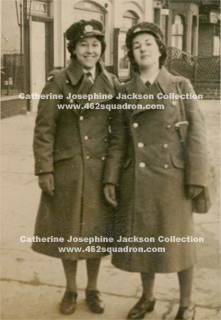
|
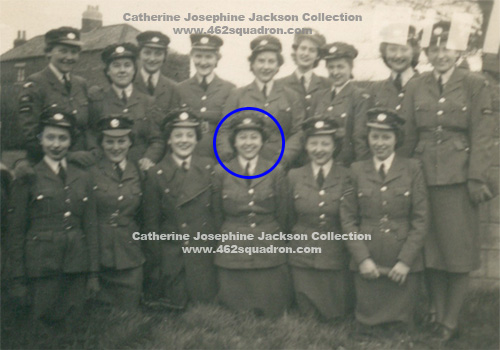
Group of 15 WAAF personnel, including Cpl Catherine Josephine WOOD-BROWN.
José is in the front row, 4th from left, at the rank of Corporal, and circled in blue. The location is not recorded, but there are too many WAAFs to only be the Met Section at Driffield. It may be WAAFs at Cranwell after completing NCO course (José promoted to Corporal), or later during José's brief posting to 617 Squadron, or possibly a group of WAAFs from several sections at Driffield (site of 462 Squadron and 466 Squadron). The building at the rear left may be definitive of location.
|
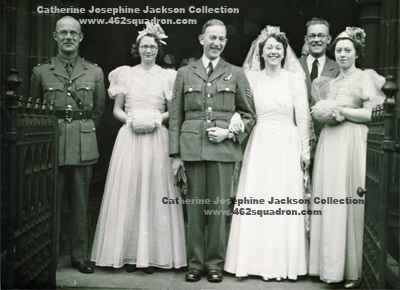
March 1942 Wedding of Catherine Josephine BURTON (José) and Sgt James WOOD-BROWN (Tim), later Pilot Officer, 144933 RAFVR.
Tim was Killed in Action in November 1943.
|

Above, L:- Margot DAVIS, Wireless Operator, Signals, Driffield;
R:- Cpl Catherine Josephine WOOD-BROWN, Met Assistant, Driffield.
|
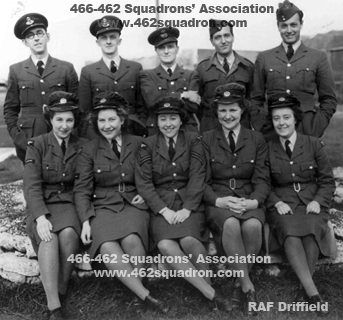
Driffield Meteorological Section personnel, 5 RAF Met Forecasters (Officers) and 5 WAAF Met Assistants
Back, L to R: 1. F/O (?) not named; 2. not named; 3. F/Lt (?) HINDS;
4. not named; 5. GOLDIE
Front, L to R: 1. LACW not named, 2. LACW DAVIES; 3. Cpl José WOOD-BROWN; 4. LACW HAWKINS; 5. LACW not named.
|

WAAF Corporal Catherine Josephine WOOD-BROWN, photo snipped and enlarged from the Met Section personnel photo shown on the left.
José was NCO in charge of the Met Section WAAFs at Driffield from October 1943 to January 1946.
|
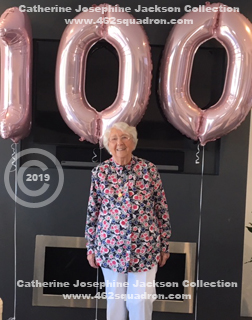
Ex-WAAF Catherine Josephine JACKSON, formerly WOOD-BROWN, nee BURTON, on her 100th Birthday, July 2019.
|

Ex-WAAF Catherine Josephine JACKSON, formerly WOOD-BROWN, nee BURTON, with cake and flowers, on her 100th Birthday, 2019.
|
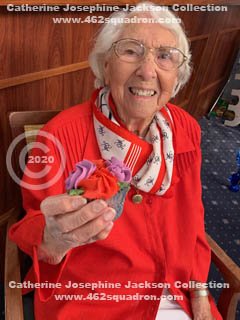
Ex-WAAF Catherine Josephine JACKSON, formerly WOOD-BROWN, nee BURTON, on her 101st Birthday, in July 2020.
Congratulations, José
|

Ex-WAAF Catherine Josephine JACKSON, formerly WOOD-BROWN, nee BURTON, on her 101st Birthday, in July 2020, with husband Maurice JACKSON.
|
Cpl Catherine Josephine WOOD-BROWN – Meteorological Section, Driffield, July 1943 to January 1946
Met office WAAFs were answerable to the Air Ministry, who decided on their postings. The Met Assistants had little daily contact with any Squadron personnel, and therefore did not get to know them. The Met Office was also very busy with 3 x 8 hours shifts, but only five Met Assistants.
Birth name Catherine Josephine BURTON, also known as José BURTON.
First married name Catherine Josephine WOOD-BROWN<, also known as José WOOD-BROWN (1942 – 1943).
Second married Catherine Josephine JACKSON, also known as José JACKSON (1962 – present).
First husband James WOOD-BROWN (known as Tim), RAFVR Sergeant Air-gunner, 2 Tours with 600 Squadron; re-trained as Pilot at Cranwell, promoted to Pilot Officer 144933; served with 158 Squadron; KIA 22 November 1943 aged 28, buried at Reichswald Forest War Cemetery, son of James and Clara.
Second husband Maurice JACKSON, ex-British Army, awarded the Legion of Honour medal by France in 2015 – aged 98 in photo with José at her 101st Birthday celebrations.
Summary of José's life, and WAAF service for the Air Ministry – extracted from a 3-page narrative in “Brave and True”; from transcription of interview by W/Cdr Michael GARSIDE on 13 August 2019; from her personal documents, and emails to and from her daughter Beatrice; also some detail from the 462 Squadron ORB.
24 July 1919 – Born in Wigan, Lancashire, name Catherine Josephine BURTON, known as José; sister Ena (later a teacher), sister Beatrice (deceased at age 19), sister Winifred (later a Nurse), and brother William (worked in family business); their father had his own business as a Builder’s Merchant.
Educated at Woodfield Prep School; and Wigan Girls High School.
After matriculation, a student at Bellmead Training Kennels, in southern England.
03 September 1939 – WW2 declared, José was working for a retired Army Officer, who was breeding Airedale Dogs.
1941 – Engaged to an airman air-gunner, who completed two tours at 600 Squadron (Blenheim and Defiant night fighters).
October 1941 – Volunteered for the Air Force, and at Interview, indicated a preference for Meteorology.
January 1942 – Called up to start WAAF life; kitted out in Gloucester (a few days); José was 5 ft 1.5 inches tall; Service Number 2085183.
(From the website http://www.ab-ix.co.uk/rfc_raf.pdf which details RFC and RAF Service Numbers: 2085183 was issued from Series “2000000 to 2099999, allocated from May 1941 for WAAF Enrolments by I of R”) .....
[Internet search for meaning of “I of R” – rafcommands.com/forum site suggested “I of R” meant Inspector of Recruiting; or Inspectorate of Recruiting; IWM.org.uk/collections Oral History section lists a sound recording by a WAAF who was Section Officer at “WAAF Inspectorate of Recruiting” in London.)
January 1942 – Initial Training for one week at Morecambe, Lancashire coast (photo in great-coat), drills, marching.
February 1942 – Posted to Fountain’s Court, (WAAF) London, then to Lincoln-In-Fields (Air Ministry), London, to train as Meteorological Assistant; 6 weeks of study, 1 week of exams; graduated as Meteorological Assistant, and now under the control of the Air Ministry, rather than the WAAF or RAF.
March 1942 – Marriage; fiancé Sgt James WOOD-BROWN (Tim) was only granted 48 hours leave (see wedding photo).
José posted to Coastal Command, at Silloth, Cumberland, an airfield with Hudson aircraft; for a few months, then recommended for NCO.
José posted to Cranwell for an NCO course, passed – José now at rank of Corporal; requested permission from Air Ministry to remain at Cranwell, as her husband Tim was retraining there as a Pilot (Tiger Moth and Anson aircraft); Request granted.
June 1943 – José’s Sgt Air-Gunner husband graduated as a Pilot, Commissioned, rank of Pilot Officer 144933 RAFVR; followed by Conversion training; then posted to 158 Squadron at Lissett flying Halifax aircraft; José requested permission from Air Ministry to be posted there but was refused as she was only an NCO.
José posted to Coniston, Lincolnshire, 617 Squadron.
July 1943 – Posted to Driffield, and reported to the Met Office, ground floor of Flying Control building (see photo of some Control Tower personnel), where her personal bicycle had been flown up from Coniston, and was waiting for her when she arrived. The Fire Brigade Boys painted her WAAF Service Number 2085183 down the bar in large white letters.
The Met Office – five forecasters (Officers) and five Met Assistants; one an NCO, i.e. José (see Met Office photo, not all named).
Lived in a Nissen Hut with 5 Met Assistants and five Wireless Operators – their hut got shot up by a German aircraft, but other than very bad fright, no physical injuries.
October 1943 to January 1946 – José was NCO in charge of the 5 Meteorological Assistants at Driffield.
Driffield Met Office – had responsibility to decide when FIDO was to be used, José went to Carnaby to witness the sigh.
[FIDO – Fog Intensive Dispersal of; originally – Fog Investigation Dispersal Operation; fuel in pipes located beside runways, with burners at intervals along the pipes, fuel under pressure, lit to burn off fog, used fuel at a very high rate; Foulsham Airfield was later was equipped with FIDO.]
José’s work when on duty, included producing a weather forecast every 3 hours; recording cloud cover, cloud type and height; using a Stevenson screen (louvred wooden structure containing weather instruments), recording maximum and minimum temperatures using thermometers, using anemometer for wind force, and barometer for atmospheric pressure; all recordings were then converted to a code of 5 numbers, and Driffield code 279; coded report sent by teleprinter to Air Ministry at 10 minutes to every hour; and received incoming reports at 10 past the hour. Drawing weather charts – then the Officer Forecaster read the charts and estimated weather at take-off, over target, and at ETA.
Met Office worked 3 x 8 hour shifts per day, with only Five Met Assistants, but only one on duty – so very busy – work and sleep, no time for social life or meeting other WAAFs. As NCO, José also had to do the duty rosters for the Met Assistants. Little to no contact with any crews. Too distant to return home on 48-hour leave, but occasionally went on leave with one of the WAAF Wireless Operators to her nearby home; As Corporal was not able to go to the Sergeant’s Mess, so made few personal friends; some free time helping at the WVS Canteen; was not allowed to keep a diary due to high security, and was not allowed to take photos.
23 November 1943 – Before arriving at the Met Office, José was waylaid and taken to the Ops room, to receive the news that her husband and his crew had failed to return from an Op to Berlin; given one week’s Compassionate Leave, staying with her parents (then in Cornwall). Death of James WOOD-BROWN later recorded in CWGC as 22 November 1943.
March 1944 – Red Cross report that there was only one survivor/PoW (Mid-Upper Gunner, RCAF) of the crew of 7 from her husband's plane; the Pilot and the other 5 crew members were given a Military funeral in the village churchyard by the villagers; remains later relocated to a CWGC cemetery.
Late 1944 – Air Ministry offered José a position in Cairo at rank of Sergeant; for two years – offer refused, but later regretted.
Post-war – José and another WAAF were taken on a flight to view bombing damage over Cologne; at 5ft 1.5 and wearing a Mae West, José had difficulty getting in the Halifax, so one of the crew “picked me up and threw me in”. Very mixed feelings; these flights were then stopped.
January 1946 – left Driffield and the WAAF, returned home.
Commenced training in London in Physiotherapy, then returned home for six months to nurse her father who had cancer; did not return to Physiotherapy Training.
Worked as Book-keeper in various companies.
1952 – Spent 6 months travelling in Africa, Rhodesia (Zimbabwe) and South Africa; caught malaria.
1962 – Married Maurice JACKSON, ex-Army, Leicester Artillery; his WW2 service had been in Europe and Iceland; post-war, he had returned to civilian work at the same pre-war engineering firm; went to live in Leicester, they had a daughter Beatrice.
1968 – José and Maurice JACKSON, and daughter Beatrice, emigrated from the UK, settling in Western Australia.
July 2019 – José's 100th Birthday (see photos) Congratulatory letters received from The Queen, The Australian Prime Minister, the Premier of New South Wales, The Australian Defence Minister, and many others.
13 August 2019 – Interviewed by W/Cdr Michael GARSIDE; transcription of interview, 22-page-pdf, used with permission.
On 22 August 202, GPCAPT David Fredericks, Director, Directorate of History and Heritage Services, History and Heritage – Air Force, granted approval for the interview to be used as proposed. The transcription of the Interview was provided by the History and Heritage Branch – Air Force. Please note that the interview cannot be further reproduced or used without written consent from History and Heritage Branch, with contact via email at HH-AF.engagement@defence.gov.au
Link to attached transcription ...... Transcript_-_Cpl_Catherine_Josephine_Jackson_13.08.19_web.pdf
July 2020 – José's 101st Birthday (see photos) – Maurice (aged 98) and José live in New South Wales, as does Beatrice.
José’s Narrative on life at Driffield in two parts (supplied by her daughter and used with permission), quoted below ….
AN ENGLISH WAAF IN WARTIME by José Jackson (formerly Wood-Brown, nee Burton) – digital file dated 05 April 2011
The first week was very much a culture shock. January in England is not the best time to spend a night away from the comfort of home, and into a wooden hut, with nineteen assorted apprehensive girls. As we were all volunteers we could at this stage still change minds.
We received our kit!! I am small, by the time I reached the end of the very long bench, with items being piled onto my outstretched arms, I could hardly see above them. I staggered back to the hut. Anyone walking past the hut must have wondered about the hilarity going on inside. We were all shapes and sizes and so were the uniforms. We looked as if we were dressed for a concert party.
After one week I was moved to Morecambe on the North West Coast to do my ‘square bashing’.
We were billeted in private houses. Unfortunately many land-ladies only did this because the government paid them very well. There were five of us in a small terraced house, only four of everything, cups, chairs, etc, so we rotated. Sleeping was in a damp cold attic. I slept in my dressing gown. It felt even worse because we had just had our injections and were not feeling so good. I eventually made a fuss, an officer came, and on inspection she agreed it was not suitable and was never used again after we left.
One day it was snowing so hard, that as we were drilling on the promenade by the beach, the instructor was barely visible. I was at the back of the squad and suggested to the girls on either side that when the squad turned we should keep going, this we did and I don’t believe we were ever missed. We went back into town.
I was lucky I only spent one week there instead of the usual three as my course in London was now starting.
As a volunteer, after your medical and various intelligence tests, you could request which branch in which to serve. Naturally it could not be guaranteed. I had applied for meteorology as science and maths were my favourite subjects in matriculation, which was one of the criteria for Met.
In London we were lucky in being billeted in a brand new building near Victoria Station. It was originally built as flats for sale, but was commandeered by the Air Force. There were no fancy furnishings as it had only just been finished and the Air Force gave us the bare essentials, but to us it was luxury. Also luck was with us, no bombing during that period. Though there was much devastation around and the people had suffered much heartbreak.
My Met course was at Lincoln’s Inn Fields, wonderful old buildings world famous to all lawyers. We had six weeks of lectures given by a senior meteorologist, formerly from the private sector but now Air-Ministry. These were followed by one week of exams. Once qualified as Met Assistants we were now subject to posting by Air-Ministry direct and not the WAAF. I believe this was because the early weather forecasters were civilians, also degree qualified school teachers, who answered to Air-Ministry but wore Air Force uniform.
I was now posted to Coastal Command in the North of England. From now on I was to see war tragedies at first hand.
My first day on duty in the Met Office (part of flying control building on the airfield) was to witness the tragic accident of a Hudson aircraft crashing on landing and all crew lost in the burning plane. The forecasters seeing how I was affected sympathetically taught me how to cope with such tragedies. Sadly I was going to be grateful in the future.
After a few months I left the Coastal Command station and was posted to Cranwell for a special course. How different life was here, from Hudsons. I was watching trainee pilots from Cranwell College doing “circuits and bumps” they certainly were. The young airmen were so full of enthusiasm. One Sergeant I met already had his wings, when I asked him why he was on a pilots course, he said he had been sent there as a punishment for flying aircraft upside down across an airfield. Eventually he left with a commission.
While on duty one day a terrible thunderstorm, with gale force winds came over the airfield, those young pilots in Ansons and Tiger Moths were told to stay airborne. Some planes on the ground were blown over. I was plotting a chart and holding the metal ends of the two pens fastened together (red and black) when a blinding flash through the window on my right struck my hand, but went on to blow up my anemometer and instrument for recording wind speed and direction. The recording pen shot off the chart and smoke came out. My hand went white and dead; with lots of massage eventually my hand returned to normal. I was told the only thing that saved me was the instrument that blew up. It took some convincing to get Group to send us another one.
After two more moves I eventually arrived at Driffield in East Yorkshire, the home of Australian Halifax squadrons 462/466 or 4 Group Bomber Command. On arrival at Met Office I was greeted with the words “your bicycle arrived by plane this morning, lucky it wasn’t dropped over Germany”.
The WAAF site was 2½ miles away from the aerodrome, out on the outskirts of town. It was a farming area and was a pleasant cycle trip back and forth to the office. The Met Office had all the ground floor of Flying Control. It contained one main room where the charts were plotted and teleprinted coded messages were sent and received. The outgoing codes were compiled from the weather details we assembled from observation and instruments. The flat roof was used to launch weather balloons, at night time with candles. On occasions I think we followed stars with the theodolite, instead of the balloon!
During the winter months life could be very uncomfortable. I can remember arriving back at my Nissen hut one night with my scarf frozen to my face.
We were an enterprising group in my hut. When fuel (1 bucket of coke per day per hut) for our slow combustion stove ran out, we used to creep out at night, climb over the fence and pinch coke from outside the cookhouse. As NCO I turned a blind eye! When our loo at the end of the hut froze, a friend and myself put hot coals on a shovel, held it over the cistern (quite a balancing act) to thaw it, and baled out with a glass probably taken from the local pub. For two days we were the only hut with one that worked.
The girls in my hut were Met, and Wireless Operators, so we all worked to a similar roster. This meant that we all understood the difficulties coming off night duty and sleeping during the day. I often came back to the hut and found someone had put a hot-water bottle in my bed. In Yorkshire that was a luxury.
Driffield had been bombed early in the war, I believe one of the first WAAFs killed was at Driffield. During the time I was there, we were not bombed but one night a German plane followed one of our Halifax’s coming back from a raid and we believe he thought the WAAF site was for airmen and he strafed us with gunfire. We hadn’t time to go to a shelter but huddled terrified in bed. We could hear the shells all round and shrapnel from the ack ack on the roof of the hut. He made numerous runs but the amazing thing was there was not one casualty apart from shattered nerves.
It sounds as if Met Assistants did all the work. We assembled all the information and plotted the charts, but the forecasters had the job of predicting the weather, a difficult job in war time with limited information from Europe. Some pilots were very cooperative and would give us an account of the weather over target, in view of the circumstances, no mean feat.
With some variations my life was similar to most WAAFs. Some had it harder and others easier, but most felt they had done what was expected of them.
Life in a Nissen Hut by José Jackson (formerly Wood-Brown nee Burton) – digital file dated 05 April 2011.
What is a Nissen hut? – A prefabricated building of corrugated steel in the shape of a half cylinder. After Peter Norman Nissen 1871-1930, a British army officer and mining engineer.
My first introduction to a Nissen hut was in 1943 when I was posted to an aerodrome in East Yorkshire in the North of England. Of course my first reaction was oh no! not in the cold of Yorkshire winters. I remained there until 1946; during those years both drama and humour were in abundance.
We had one slow combustion stove in the middle of the hut, which was reasonably large housing ten airwomen. We were only allowed one bucket of coke per day. This was a ridiculous amount for the size of the hut. WAAF are very resourceful when it comes their comfort. After dark a foray would sneak behind the cookhouse, climb over the fence (harder than it sounds) and refill the bucket. It was always surprising the ‘stage whispers” and giggles did not bring forth the guards. The trouble with coke stoves is the fumes, we needed to keep the door open quite often.
Mansion Polish – of course its main use was the polishing of floors. It was supplied in large tins, oh joy, what wonderful frying pans the lids made. After lots of cleaning they were ready to be used. Near the aerodrome was a friendly farmer who occasionally would let us buy eggs from him, at this time food was quite dramatically rationed. We would huddle around the stove in the evening (if off duty) and fry the eggs, they tasted terrific.
Simple jobs were also made easier for us by the kindness of those living off the camp such as the weekly job of getting laundry organised. The NCO responsible for the fire tenders which always stood outside flying control would make a reason for checking fire equipment in the WAAF site so he could collect and deliver our laundry.
Our WAAF camp was two miles from the airfield. (I cycled on and off duty). On one occasion we were not spared the fear of German action. Our planes had been on a mission to bomb Germany, on their way back, as occasionally happened they were followed home by a German plane. We believe our site was mistaken by the Germans as the home of the aircrew so they decided to attack it. We heard the plane circulating then we heard gunfire and the bullets ricocheted off the path outside, the shrapnel from our guns on the roof was frightening. We didn’t have time to go to a shelter. The hut had only one window at the end, as I was the NCO it was supposed to be a privilege to have the end bed. Feeling very vulnerable under the window, I shot out of bed and rushed down the hut and jumped into a friend’s bed without warning, she let out a yell thinking she had been hit. They are very narrow beds not made for two! We were shaking so much you could almost hear the bed creaking. Then bit by bit we checked to see if everyone was alright. All this time more and more shooting was going on. All seemed OK except we had no response from a girl called Betty, we presumed she was sleeping through it, much to our annoyance. In the morning when all was quiet, she told us she was lying there with her mouth wide open but no sound would come as she was so frightened. Everyone has their own reaction to fear. The happy ending was no one on the camp was injured.
On a lighter note one of our ideas we realised in later years was foolhardy concerning the thawing of a loo. During one of Yorkshire's very cold winters, the loo at the end of the hut froze and the roof was covered with snow. It was the old fashioned chain type of cistern. Two of us decided something had to be done. No outside help was offered. We put red hot coke on a shovel held it over the cistern to thaw it, and baled out with a glass probably taken from the local pub. Balancing on the loo really was a risky business. It worked, we were the only hut (not counting the main ablution block) that had a working loo.
Many of us remained friends until age took its toll.
(End of José's narrative)
Thank you José, for sharing your memories on this site; and thank you Beatrice (José's daughter), for acting as intermediary.
Return to top
|
WAAF Recruitment Poster
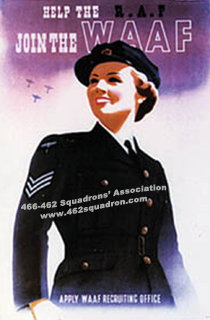
WAAF Recruitment poster
"HELP THE R.A.F.
JOIN THE WAAF
APPLY WAAF RECRUITING OFFICE"
Return to top
|
FOULSHAM
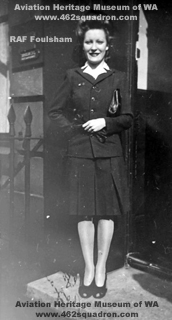
WAAF Waitress from the Squadron Mess, Foulsham – not named, and not recorded whether from Officers' Mess, or Sergeants' Mess. Sign on wall (upper left) and possible signature (lower left) were not decipherable on enlargement.
Return to top
|
| |
|
| ACW2 Winifred Joan HAWGOOD, Wireless Operator, Signals, Control Tower, Foulsham |
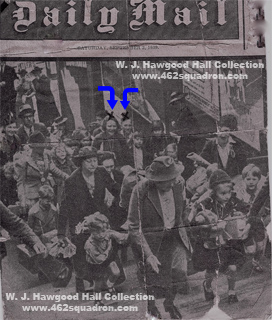
Winifred Joan HAWGOOD, aged 13, and her younger brother Berkley HAWGOOD, (blue arrows above old X marks) and other children from their school, at St Pancras Station, London, for evacuation from the city on 01 September 1939. Photo published in the Daily Mail newspaper on Saturday 02 September 1939. Joan and Berkley stayed together with the COLEMAN family in Irchester, Northamptonshire.
|
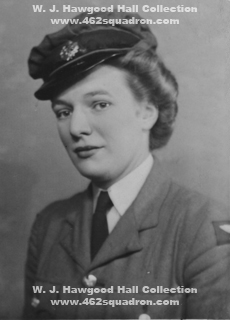
Winifred Joan Hawgood, WAAF 2149994, sometime in February or March 1944, after reporting for regular service on 17 February 1944.
After training as a Wireless Operator, Joan was posted to Foulsham, the site of 462 Squadron and 192 Squadron.
|
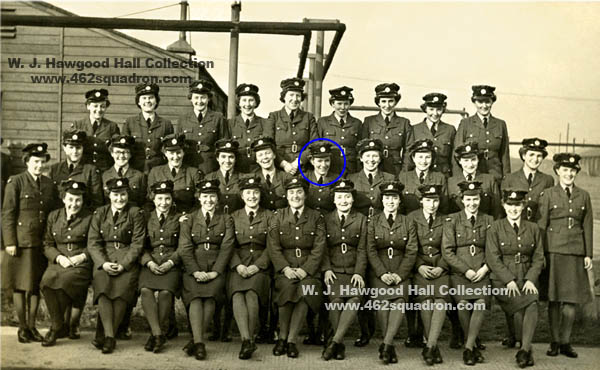
32 WAAFs at Wilmslow, near Manchester, after Graduation from Basic Training, Company C, Huts 2 – 5, February 1944.
Back row: 1 to 9 – not named.
Middle row, standing, L to R: left 1. "Scottie", 2, 3, 4, 5, 6. Ellen SCOTT, 7. Winifred Joan HAWGOOD, WAAF 2149994 (with blue circle); 8 to 12 not named.
Front row, sitting, L to R: 1, 2, 3, 4, 5, not named; 6 "Sergeant"; 7 to 11 not named.
"Sergeant" was the drill/marching leader – but still wearing the 2 stripes of Corporal, so maybe an Acting/Sgt (?)
Joan said they are all looking very happy, because they knew they were finished with marching every morning at 5am.
The back of the photo had been signed, as shown below left.
|

Signatures on back of photo of WAAFs at Wilmslow, near Manchester, after Graduation from Basic Training, Company C, Huts 2 – 5, February 1944.
Names as signed are not in order of that person's position in photo. Names are listed in Joan's Service History recorded below.
|
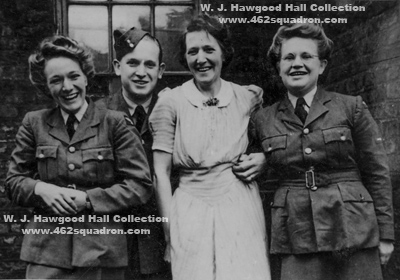
L to R: 1. Winifred Joan HAWGOOD, WAAF on her first leave home to London;
2. Joan's older brother Geoffrey HAWGOOD, RAF;
3. their mother Winefred HAWGOOD;
4. Joan's older sister Phyllis Hawgood, WAAF.
Younger brother Berkley also joined the RAF.
Siblings by age, from oldest – Phyllis (WAAF 1940); Geoffrey (RAF 1942); Joan (WAAF 1944); Berkley (RAF 1945).
|
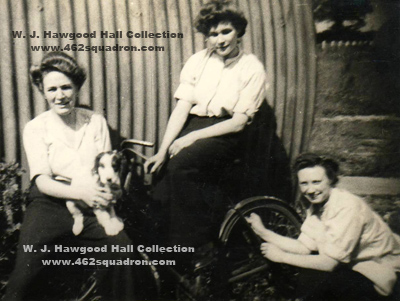
Above left – Winifred Joan Hawgood, holding the dog;
centre – seated on the bicycle, Joan BAXTER;
right – Shiela (or Sheila); outside Nissen Hut 2 on the WAAF site. All three were WAAF Wireless Operators from Signals, RAF Foulsham, Joan said they were not allowed to have dogs, so it was either an Officer's dog, or a stray, or from one of the nearby farms.
|
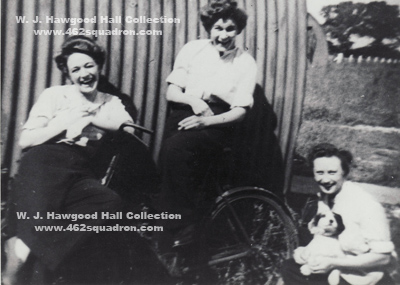
Above left – Winifred Joan Hawgood;
centre – seated on the bicycle, Joan BAXTER;
right – Shiela (or Sheila), holding the dog; outside Nissen Hut 2 on the WAAF site. Dated as July (at left) or October 1944 (above), but probably taken in close sequence, with something making them laugh.
|
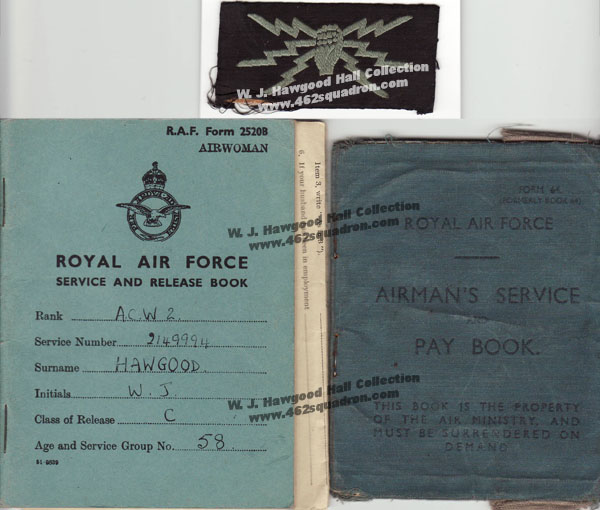
ACW2 Winifred Joan Hawgood WAAF 2149994,
Above top –
Wireless Operator's cloth badge of trade, "sparks", hand holding 3 bolts of lightning;
Above left – Service and Release Book (Form 2520B)
Above right – Pay Book (Form 64) – shown open below.
|
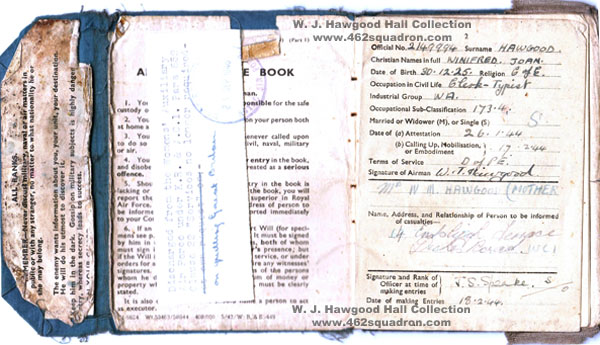
Winifred Joan Hawgood WAAF 2149994, Pay Book (Form 64)
Details include date of birth, 30 December 1925; religion Church of England; Civilian occupation Clerk-Typist; Single;
Date of Attestation 26 January 1944; date of reporting for service 17 February 1944 for Duration of Present Emergency;
casualty reports to Mrs W M HAWGOOD, (Mother) of 64 Endsleigh Terrace, .... illegible
The slip of paper inserted sideways on the left, reads ......
Discharged from the Women's Auxiliary Air Force under K.R. & A.C.I., Para 652, Clause 22 "Services no longer required – on quitting Great Britain". (i.e. King's Regulations and Air Council Instructions, also recorded on Statement of Service, below)
|
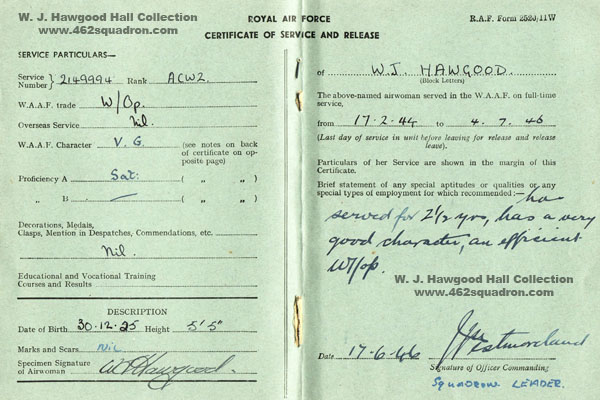
Winifred Joan Hawgood WAAF 2149994, Certificate of Service and Release (Form 2520/11W)
Trade – Wireless Operator, Character Very Good, Proficiency Satisfactory; service from 17 February 1944 to 04 July 1946.
Signed by Squadron Leader Westmoreland (?) on 17 June 1946, with comment ......
"has served for 2½ years, has a very good character, an efficient W/op".
|

Winifred Joan Hawgood WAAF 2149994, Statement of Service (Form 1934) dated for Discharge from the Service on 23 September 1946.
Date of enrolment – 26 January 1944
Reported for regular service – 17 February 1944
released from service 06 July 1946 at rank of Aircraftwoman 2nd class (ACW2) – "Services no longer required – on quitting Great Britain".
Note item (g) – "Has a very good character and an efficient Wireless Operator"
|
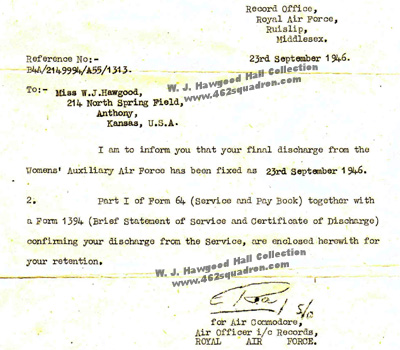
Winifred Joan Hawgood WAAF 2149994, letter dated 23 September 1946, which companied the Statement of Service (at left), and Income Tax form (not shown, details below; letter and statement both reduced in size from original).
From the RAF Records Office at Ruislip, Middlesex, it was addressed to Miss J W Hawgood at her forwarding address in Kansas, USA. She embarked from Southampton, England on 07 October 1946
An additional document was Part I of Pay Book 2520 – a "Leaving Certificate – Airwoman, Income Tax" (Form 2520/16W) – which recorded that, at the rank of ACW2, her final rate of pay on the date of Release from Service was 3 shillings and 8 pence per day. It further noted that the rate of pay had increased from 3 shilling per day, to the higher amount, with effect from 01 July 1946. It was signed off by F/O J W McRAE and rubber-stamped at 105 Personnel Dispersal Centre (105 PDC), on 05 July 1946, the effective day of Release.
|
ACW2 Winifred Joan HAWGOOD, Wireless Operator, Signals, Control Tower, Foulsham
Birth name Winifred Joan HAWGOOD
Married name Winifred Joan HAWGOOD HALL
Summary of Joan's Life, and WAAF Service History – extracted from a 2-page article in “Flight Journal”, December 2014, pages 34-35, and the Journal Editor’s note on page 8; information also from scans and photos of Joan’s various WW2 WAAF documents; and from many emails to and from Joan via her son William M HALL (Bill); also some detail from the 462 Squadron ORB.
30 December 1925 – Birth of Winifred Joan HAWGOOD, the third of 4 children, all of whom joined the RAF or WAAF in WW2
01 September 1939 – Joan aged 13, and younger brother Berkley were evacuated from London with other children from their London school; a photo of the group at St Pancras Station was published in the “Daily Mail” newspaper the next day (see photo in previous section). They were billeted for 2 years with the Coleman family in Irchester in Northamptonshire. Joan rode by bicycle to school at Rushden. They sometimes returned by bus to London for a weekend, including once in late 1940, when “London burned”.
March 1941 – back in London, Joan and her brother would go on roof of their flat, to throw bomb fragments off, so the roof wouldn’t catch fire; once a V1 bomb hit the building next door and the whole street (of wooden buildings) was on fire.
03 January 1944 – Attempted to enlist as a WREN for Radar training, but did not qualify based on her education.
January 1944 – Volunteered for the Women’s Auxiliary Air Force, former civilian occupation Clerk-Typist; Religion Church of England; single, height 5 ft 5 inches (more details with each of Joan’s WAAF documents shown previously).
26 January 1944 – date of Attestation; Official WAAF Number 2149994.
(From the website http://www.ab-ix.co.uk/rfc_raf.pdf which details RFC and RAF Service Numbers: 2149994 was issued from Series “2100000 to 2199999, allocated from August 1942 for WAAF Enrolments by I of R”) ...
[I of R – WAAF Inspectorate of Recruiting.]
17 February 1944 – Reported for Service in the WAAF.
17 February 1944 – Travelled by train to Wilmslow, near Manchester, for 3 weeks of Basic Training (photo of Company C, Huts 2 – 5 after Graduation. Two of the Wilmslow WAAFs, after further training, were also posted as W/Ops to Foulsham, to serve with Joan – possibly Joan Baxter and Sheila (?) in the Foulsham photo – however their signatures were not on the Wilmslow photo, and they have not yet been matched visually with the faces on it.
24 or 25 Names from back of the WAAF group photo at Wilmslow, some signatures are very hard to decipher, so errors may be present; WAAFs signatures are NOT in the same order as their position in the photo –
Dora M Burditt, Muriel Bervie, Mary Welsh, Betty Willsher, Helen Barfoot, Iris Jones, Ellen Scott (middle row, left of Winifred Joan HAWGOOD who is circled in the photo) Marcella M Garls (or Grath ?), J Lord, Vera F Knight, Margaret Fraser, Mary Leslie, ‘Hey little hen’ Jean Thompson, Scottie (standing far left in the photo), Muriel B Thompson, Helen Adie, Chris Fleming (or Heming); Isabel Callander (or Isabel CD Sanders), Margaret Robertson, J Plummer, J D Cooke, Essie Phin (or Effie Phien), Esther Wilson, Isabel Strang.
Statement with signatures – "get your shoes in a straight line” above illegible Esse Beettby (?) …. refers to song they sang which said in part "keep our shoes so shiney and something is always bright – from morning until night".
“To Hut 2 ‘Mrs Mopp’” refers to all the cleaning they had to do prior to each inspection, over the 3 weeks of training.
March 1944 – Formal portrait photo of Joan in uniform, during her first Leave after completing Basic Training.
11 March 1944 – Travelled by train to Blackpool for Initial Signals Training. 8 Weeks; trained as Wireless Operator (radio) using Morse Code (see photo of her W/Op cloth badge).
10 June 1944 – Travelled by train to Compton Bassett, Wiltshire, for Advanced Signals Training, and Set Repair.
08 July 1944 – Leave, in London with family (see photo). All four siblings joined the Air Force, and all 4 survived war. From the eldest to youngest – Phyllis, joined WAAF in 1940; Geoffrey RAF 1942; Joan WAAF 1944; Berkley RAF 1945.
09 September 1944 – Travelled by train to Foulsham Aerodrome, duty in Signals.
September 1944 to July 1945 – Posted to RAF Station Foulsham, Norfolk, 100 Group, in Bomber Command – not posted to any particular squadron, but duties as Wireless Operator in support of 192 Squadron (August to end December 1944); and in support of 462 Squadron from January to September 1945. At the time, there were about 3000 “Brits and Aussies” and 95 WAAF, with 12 WAAF girls to each Nissen hut on the WAAF site. (See 2 photos at Foulsham, outside Nissen Hut 2, Joan HAWGOOD with Joan BAXTER and Sheila. Two of the WAAF recruits at Wilmslow Basic Training in February 1944, also ended up at Foulsham – perhaps Joan B and Sheila? or perhaps Ellen Scott and Scottie as named in the Wilmslow photo?)
Everyone in Nissen Hut 2 at Foulsham was a Wireless Operator in Signals, and worked in rotating shifts, with 3 WAAFs per shift. Joan’s Signals Unit had 20 fewer W/Ops that they needed, so life was either working, sleeping, eating, washing etc., with rarely any free time to leave the WAAF area; cycling between the Nissen Hut and the Control Tower at all hours and in all weather; Joan vividly remember riding her bike the 3km to her hut from Signals when the FIDO system was operating (flaming jets of burning fuel alongside the runway, to burn off fog, allowing aircraft to land).
All signals were coded, no plain language, except for SOS. Due to the nature of the shift work Joan did not know many air crew personally; was not allowed on any of the taxi-ways or main runways; the only exception being when she had to meet at dispersal for her one and only flight (see below 11 May 1945).
Joan did hand embroidery in her spare time at Foulsham, one item of which is still hanging in her son’s home – the embroidery was on linen, which had been retrieved from inside a crashed Hurricane, and given to Joan by her older sister Phyllis, who was a member of a WAAF Fighter Reclamation crew.
Joan has always noted that 462 Squadron “with all the Australian and New Zealand airmen” was at Foulsham when she was there, so obviously memories of them are stronger.
Her son Bill said Joan has really been surprised at how much “secret stuff” was going on at Foulsham, things that she knew nothing about, until recently. This shows how good the security was on site at that time. Also, she was amazed at the Nose Art on some 462 Squadron planes, as she was not allowed to be close enough to see them.
Joan particularly remembers S/Ldr Alan SWANN, and his flower garden, and being assigned by him to fill in at the switchboard due to short-staffing. He also authorised her Flight over Germany (see below 11 May 1945).
Joan also remembers sports games she ran in; and times when multiple planes went down; and when a Halifax crashed at the base. These memories relate to ………..
24/25 February 1945, loss of four Crews on an Op to the Ruhr – Halifax PN429 Z5-E TOOTAL Crew 57; Halifax MZ447 Z5-A, RATE Crew 13; Halifax MZ448 Z5-W, RIDGEWELL Crew 37; Halifax MZ461 Z5-O, ELY Crew 39.
14 January 1945 – Halifax LL598 Z5-A, ASTILL Crew 52 crashed soon after take-off from Foulsham.
04 April 1945 – Halifax LG432 Z5-A, O’SULLIVAN crash landed on return from Op, overshot runway at Foulsham due to engine trouble, undercarriage collapsed.
10 April 1945 – Loss of Halifax NA240 Z5-V, BALL Crew 59 – as WAAF's were scarce for signals, Joan has no doubt she was on duty at either take-off time, or at the expected return time.
11 May 1945 – just after VE Day, while working in Signals, Joan was asked (to her surprise) if she would like to fly on reconnaissance; and was told to be at Dispersal in readiness at 8:00am next day. Flight was for 8 hours with an Aussie crew, flying over Holland, and over Cologne, returning over France and Dover. She was the only WAAF on the flight, which was authorised by the Signals Commander, and S/Ldr Alan Swann of 462 Squadron. Joan crawled into the aircraft nose, and climbed into the mid-upper turret (but not the rear turret), and also sat in the W/Ops alcove, and in other parts of the Halifax.
These “Cook’s Tours” are mentioned in the 462 Squadron Operational Record Book, but only rarely record the Pilot’s name, but not the crew or passenger names, and not even the Halifax serial number. Joan is sure of the date, as she was on a 48 hour Leave Pass, so was not on site at Foulsham on 07 May or 08 May 1945; she was back on duty on 09 May, and was offered the flight on her return to Signals. ORB, Form 540, page 78 …… 8 May, VE day- no flying; 09 May – no flying; 10 May – no training; 11 May – “4 aircraft on Cross Country flights, to enable the air crew and some ground personnel to see the destruction that had been caused in the RUHR and other areas. Each aircraft carried a total of fourteen passengers and Crew”. Joan particularly remembers a Jamaican on her flight – possibly LAC Mitchell, from Foulsham Station Headquarters, the only Jamaican mentioned anywhere in the 462 Squadron ORB (noted as having outstanding performance at the Station Annual Sports Day on 14 July 1945, events contested between 462 Squadron, 192 Squadron and Station HQ). In the 462 Squadron ORB, the first mention of other WAAFs on similar flights at Foulsham, was not recorded until 16 July 1945.
07 July 1945 – Transferred to RAF St Athan, Wales; taking up duty as Base Commander’s Secretary.
17 June 1946 – Certificate of Service – full-time service from 17 February 1944 to 04 July 1946 (RAF Form 2520/11W, shown previously) – note the reference for special aptitudes or qualities ….. "has served for 2½ years, has a very good character, an efficient W/op".
01 July 1946 – pay increase from 3 shillings per day, to 3 shillings 8 pence per day.
05 July 1946 – effective date of Release from WAAF (RAF Form 2520/16W, not shown); at the rank of ACW2; dated and stamped at 105 PDC.
06 July 1946 – Released from Service at St Athan, Wales.
July to September 1946 – worked at a modelling agency in London, partly due to the time involved in obtaining Visa, Passport and making travel arrangements, etc.
23 September 1946 – official date of discharge from the WAAF, in letter which companied the Statement of Service (shown previously, with details), and RAF Income Tax form (not shown); note that the letter was addressed to Joan HAWGOOD at an address in Kansas, USA.
07 October 1946 – Winifred Joan HAWGOOD sailed from Southampton, England on the SS Washington, to travel to the USA to marry the American who had “swept her off her feet”.
14 October 1946 – Arrived in Manhattan, USA; travelled by Fast Train to St Louis; travelled by train to Wichita, Kansas (see article written in 2005, below).
Married the former US Army Serviceman she had fallen in love with in England; now Winifred Joan HAWGOOD HALL.
July 1953 – Became as American citizen.
28 August 2005 – Joan wrote the following article “WHAT GAME? – October 14. 1946”
W.JOAN HALL, 607C.N.W. LILAC PLACE, LEES SUMMIT, MO.64081. Written 28 AUGUST 2005.
WHAT GAME?
October 14. 1946. I arrived in the USA on the S.S. Washington having sailed from Southampton, England on October 7. Never will I forget sailing up the Hudson and seeing
the Statue of Liberty at 5.a.m. What a sight, I had heard about it but until it is seen for the
first time, it is not real. Then the Manhattan skyline, very different now from what it was
in 1946. There was no smog, but a beautiful mist over it, it was like a fairyland, and having
never seen a building more than 4 stories high, it was incredible.
Taxi to TWA office near
Grand Central Station where I changed my air ticket to Wichita Kansas to a rail ticket. All
my life I had dodged traffic in London, who ever crossed at a crosswalk. I stepped into the
road, completely forgetting the traffic moved in the opposite direction, good, no traffic coming, off I went. Oh my, horns blared, a lorry driver swore at me, and a policeman
grabbed me. “What the …. do you think you are doing” “Just crossing the road” Into the
railway station, stopped for a meal. Paid the bill at the counter. “Why do they have orange sticks at the checkout” (that what we used for our fingernails) I had never seen a
toothpick container.
Fast train to St. Louis, looking all the time for an elevator. So many times American had said they came from “A small town with an Elevator” I thought they meant a “Lift” as we had in the department stores. That’s what the Americans called our
Lifts – “Elevators”. I had visions of a square box with a lift just going up and down, no
special reason, just crazy Americans, no one explained it was a very large and white and it held Grain.
Arrive in Union Station St. Louis, such a kind Red Cap, helped me with my
luggage, took me to the Luggage check in and told me what time my train left for Wichita.
Behind the counter a young man, and a large board on an easel with something written on
it.
“Hi” he says as he takes the luggage “who’s going to win today”
“Win what” I said
“The Game” he said
“What game” I said
“The series” he said
“What series” I said “I have
no idea what you are talking about”
“My…” he said “Where did you come from”
“I just
got off the train” I said, and walked away to a small restaurant. I sat down; a waitress
came and immediately put water down. My goodness I thought, I didn’t ask for that,
“What’ll you have”
“A pot of tea for one please and a currant bun:”
“A what?”
“Oh one of
those on the counter please” I had no idea what they were, but it looked edible, it was a
Danish. The waitress brought the order, a cup of luke warm water with this funny looking
little sack in the saucer, my goodness what is this, my first introduction to the tea bag.
Train to Wichita, people parading up and down in the aisle with horn and noisemakers,
singing, shouting. Oh Dear what have I done – why did I not stay in dear old London – these people are all mad.
I still do not know who won the Series that day October 15 1946.
I
became as American citizen in July 1953, and love this country.
December 2014 – Article “Eyewitness to History – A childhood interrupted” by W Joan HAWGOOD HALL, former ACW2 (then aged 88 years), was published in “Flight Journal”, December 2014, journal pages 34-35, with Editor’s note on journal page 8. Scan copy is used on this website with the permission of the journal’s current senior Technical Editor, Gerry YARRIS, who granted approval for use by email on 20 August 2020. Please note that the article cannot be further reproduced or used without written consent from the flightjournal.com Editor.
Note also that the article mentions Lancaster bombers at Foulsham – an unintentional error for Halifax bombers. The first photo in the article, shows Joan and her brother Berkley at St Pancras station in 1939 (photo also on this site), however the second photo of children beside a train at a different station, was not of Joan’s school group (source unknown, used by the then Editor for effect). Link to article ...... 1412_WJH_Flight_Journal_Article_web.PDF
September 2020 – Joan, aged "a sharp 94", is living in Colorado, USA, and has very strong and accurate memories of her WAAF service at Foulsham. Over the years, Joan has given talks about her time as a WAAF Wireless Operator in WW2.
Thank you Joan, for sharing your memories on this site; and thank you Bill (Joan's son), for acting as intermediary.
Return to top |
| |
|
 to Squadron Crews UK to Squadron Crews UK
|
|
|
|
|
|
|
|
|
|

_(Admin)_Wilson_X_Irvine_web.jpg)

























